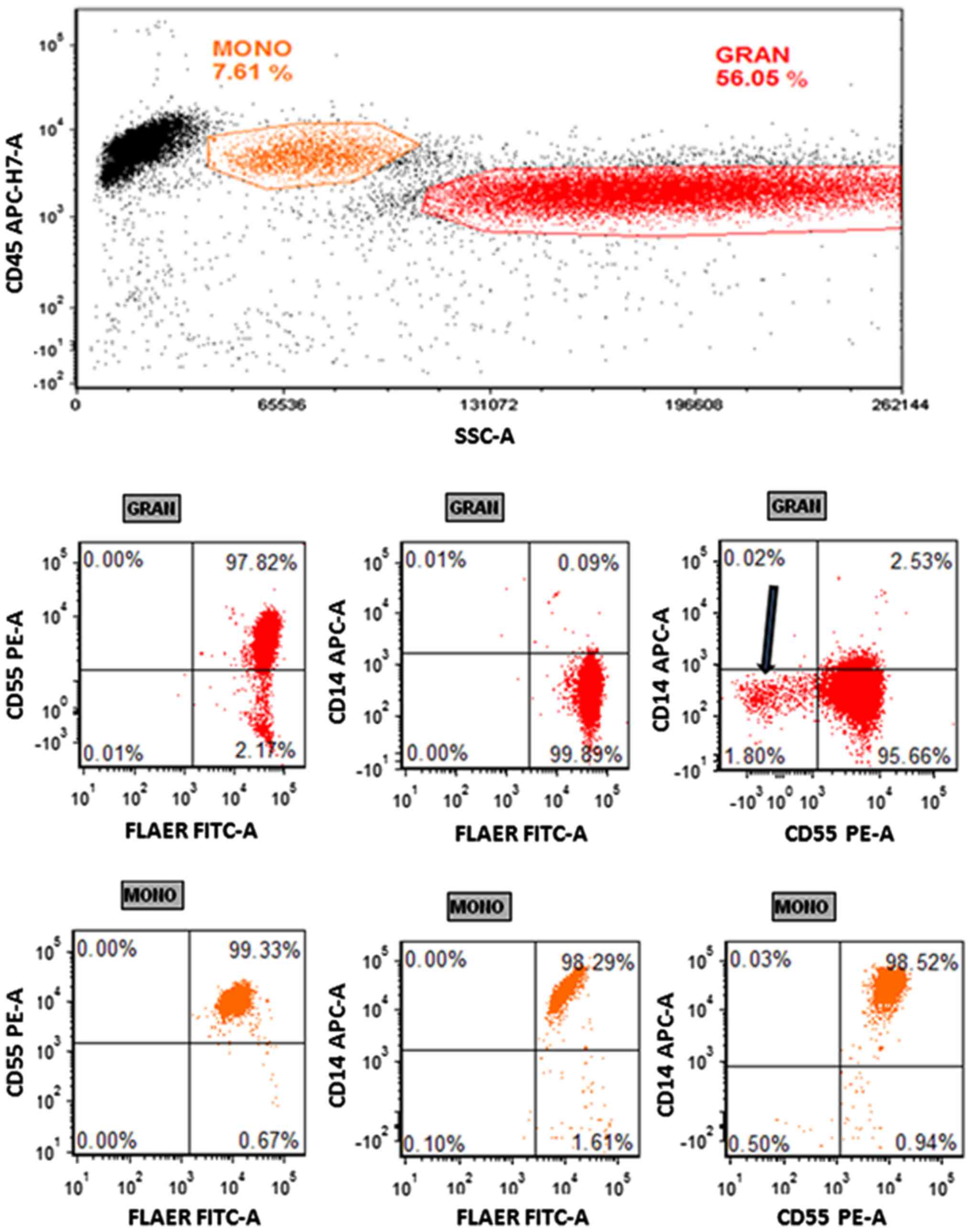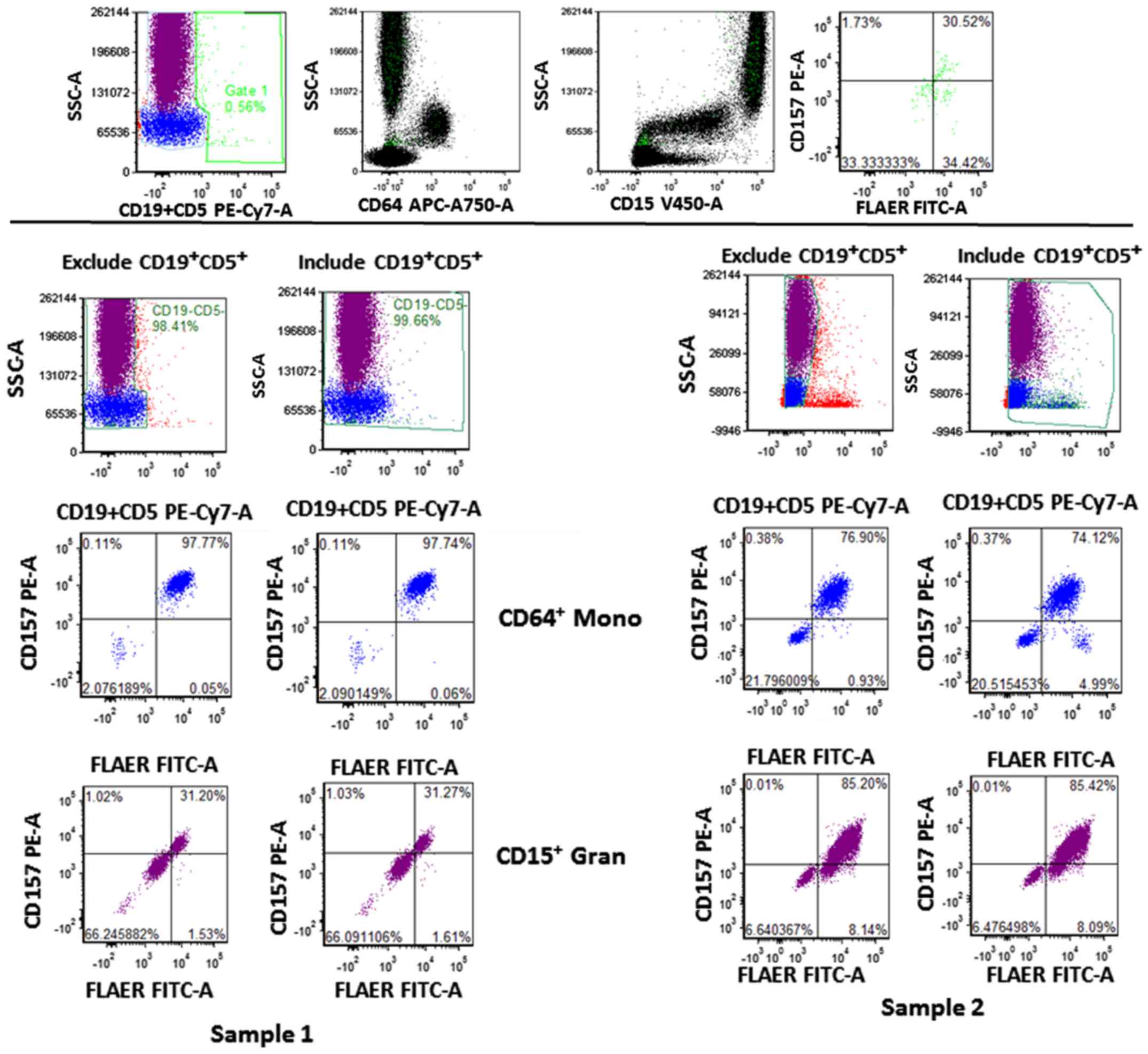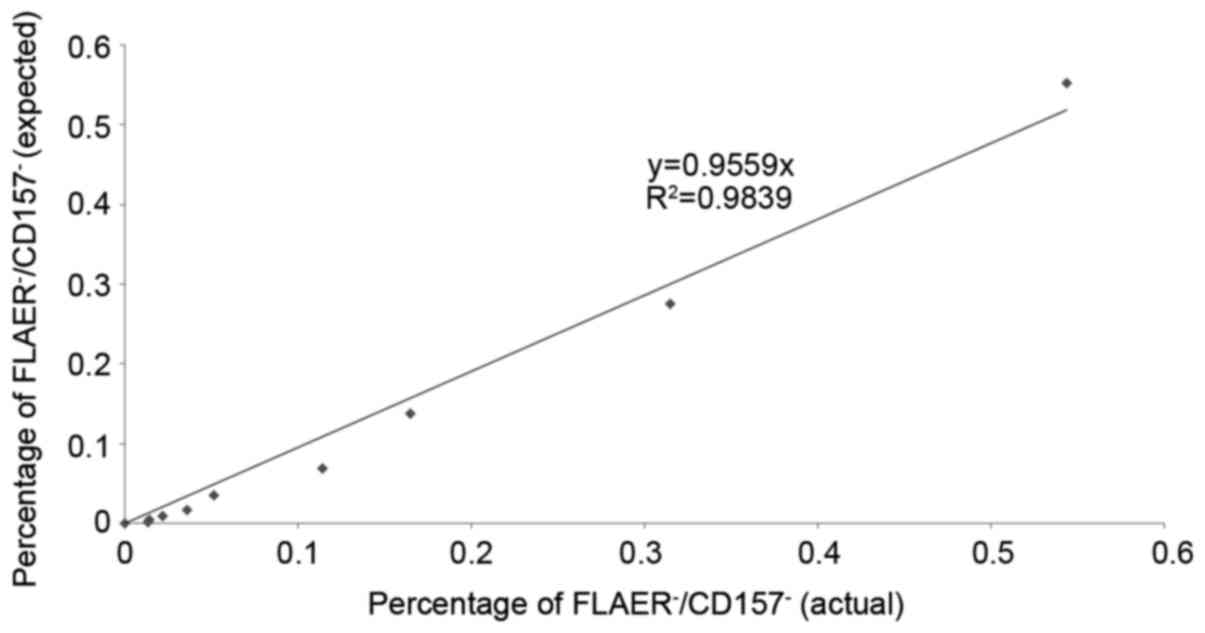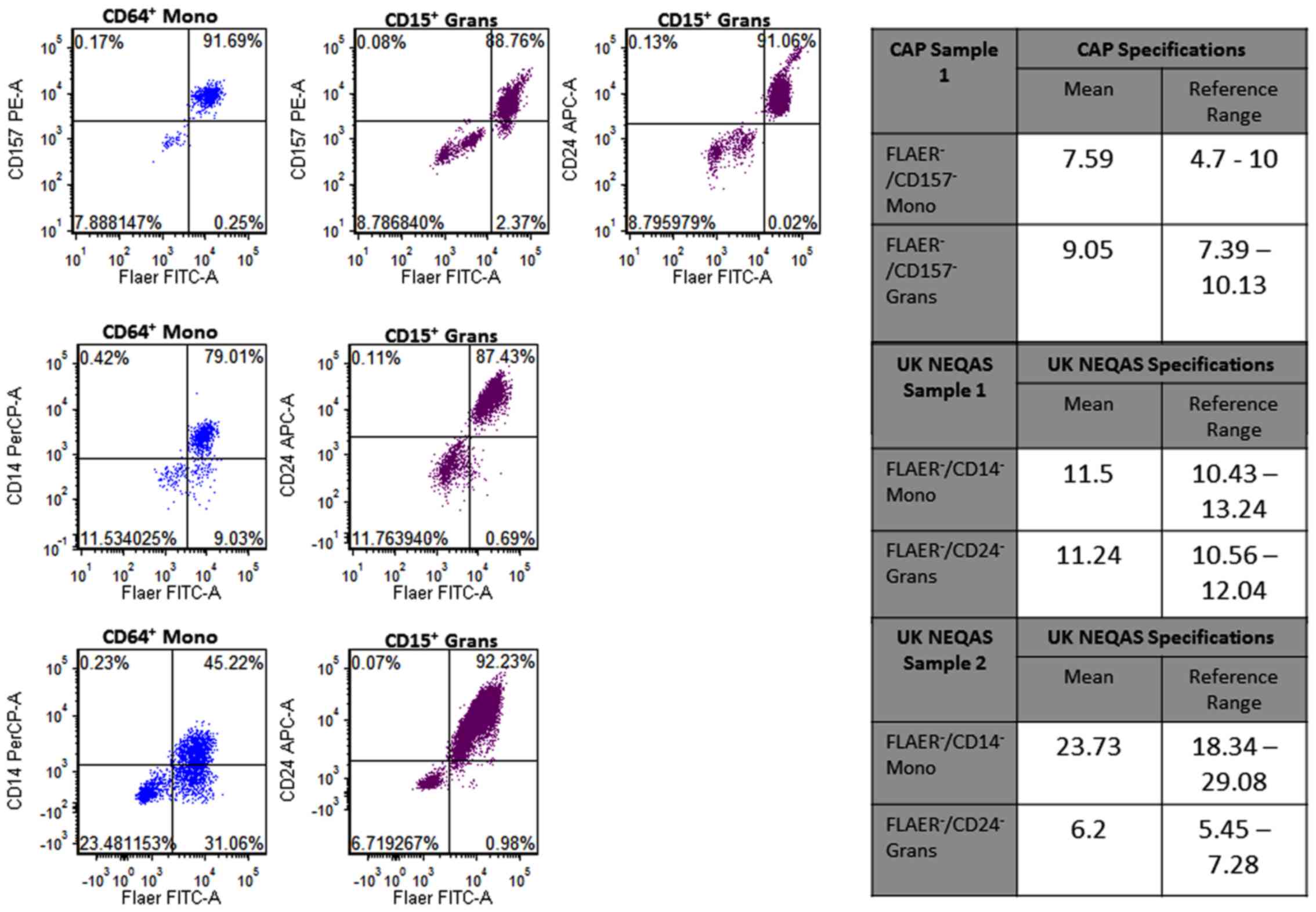|
1
|
Chattopadhyay PK, Perfetto SP and Roederer
M: The colorful future of cell analysis by flow cytometry. Discov
Med. 4:255–262. 2004.PubMed/NCBI
|
|
2
|
Chan RC, Kotner JS, Chuang CM and Gaur A:
Stabilization of pre-optimized multicolor antibody cocktails for
flow cytometry applications. Cytometry B Clin Cytom. 92:508–524.
2017. View Article : Google Scholar : PubMed/NCBI
|
|
3
|
Hill A, Platts PJ, Smith A, Richards SJ,
Cullen MJ, Hill QA, Roman E and Hillmen P: The incidence and
prevalence of paroxysmal nocturnal hemoglobinuria (PNH) and
survival of patients in Yorkshire. Blood. 108:9852006.
|
|
4
|
Parker C, Omine M, Richards S, Nishimura
J, Bessler M, Ware R, Hillmen P, Luzzatto L, Young N, Kinoshita T,
et al International PNH Interest Group, : Diagnosis and management
of paroxysmal nocturnal hemoglobinuria. Blood. 106:3699–3709. 2005.
View Article : Google Scholar : PubMed/NCBI
|
|
5
|
Hosokawa K, Kajigaya S, Keyvanfar K, Qiao
W, Xie Y, Townsley DM, Feng X and Young NS: T Cell transcriptomes
from paroxysmal nocturnal hemoglobinuria patients reveal novel
signaling pathways. J Immunol. 199:477–488. 2017. View Article : Google Scholar : PubMed/NCBI
|
|
6
|
Hill A, Ridley SH, Esser D, Oldroyd RG,
Cullen MJ, Kareclas P, Gallagher S, Smith GP, Richards SJ, White J,
et al: Protection of erythrocytes from human complement-mediated
lysis by membrane-targeted recombinant soluble CD59: A new approach
to PNH therapy. Blood. 107:2131–2137. 2006. View Article : Google Scholar : PubMed/NCBI
|
|
7
|
Al-Ani F, Chin-Yee I and Lazo-Langner A:
Eculizumab in the management of paroxysmal nocturnal
hemoglobinuria: Patient selection and special considerations. Ther
Clin Risk Manag. 12:1161–1170. 2016. View Article : Google Scholar : PubMed/NCBI
|
|
8
|
Fletcher M, Whitby L, Whitby A and Barnett
D: Current international flow cytometric practices for the
detection and monitoring of paroxysmal nocturnal haemoglobinuria
clones: A UK NEQAS survey. Cytometry B Clin Cytom. 92:266–274.
2017. View Article : Google Scholar : PubMed/NCBI
|
|
9
|
Hill A, DeZern AE, Kinoshita T and Brodsky
RA: Paroxysmal nocturnal haemoglobinuria. Nat Rev Dis Primers.
3:170282017. View Article : Google Scholar : PubMed/NCBI
|
|
10
|
Brodsky RA: Paroxysmal nocturnal
hemoglobinuria. Blood. 124:2804–2811. 2014. View Article : Google Scholar : PubMed/NCBI
|
|
11
|
Nafa K, Bessler M, Castro-Malaspina H,
Jhanwar S and Luzzatto L: The spectrum of somatic mutations in the
PIG-A gene in paroxysmal nocturnal hemoglobinuria includes large
deletions and small duplications. Blood Cells Mol Dis. 24:370–384.
1998. View Article : Google Scholar : PubMed/NCBI
|
|
12
|
Canalejo K, Riera Cervantes N, Felippo M,
Sarandría C and Aixalá M: Paroxysmal nocturnal haemoglobinuria.
Experience over a 10 years period. Int J Lab Hematol. 36:213–221.
2014. View Article : Google Scholar : PubMed/NCBI
|
|
13
|
Yamashina M, Ueda E, Kinoshita T, Takami
T, Ojima A, Ono H, Tanaka H, Kondo N, Orii T, Okada N, et al:
Inherited complete deficiency of 20-kilodalton homologous
restriction factor (CD59) as a cause of paroxysmal nocturnal
hemoglobinuria. N Engl J Med. 323:1184–1189. 1990. View Article : Google Scholar : PubMed/NCBI
|
|
14
|
Motoyama N, Okada N, Yamashina M and Okada
H: Paroxysmal nocturnal hemoglobinuria due to hereditary nucleotide
deletion in the HRF20 (CD59) gene. Eur J Immunol. 22:2669–2673.
1992. View Article : Google Scholar : PubMed/NCBI
|
|
15
|
Rother RP, Bell L, Hillmen P and Gladwin
MT: The clinical sequelae of intravascular hemolysis and
extracellular plasma hemoglobin: A novel mechanism of human
disease. JAMA. 293:1653–1662. 2005. View Article : Google Scholar : PubMed/NCBI
|
|
16
|
Hill A, Richards SJ and Hillmen P: Recent
developments in the understanding and management of paroxysmal
nocturnal haemoglobinuria. Br J Haematol. 137:181–192. 2007.
View Article : Google Scholar : PubMed/NCBI
|
|
17
|
van der Schoot CE, Huizinga TW, van't
Veer-Korthof ET, Wijmans R, Pinkster J and von dem Borne AE:
Deficiency of glycosyl-phosphatidylinositol-linked membrane
glycoproteins of leukocytes in paroxysmal nocturnal hemoglobinuria,
description of a new diagnostic cytofluorometric assay. Blood.
76:1853–1859. 1990.PubMed/NCBI
|
|
18
|
Hall SE and Rosse WF: The use of
monoclonal antibodies and flow cytometry in the diagnosis of
paroxysmal nocturnal hemoglobinuria. Blood. 87:5332–5340.
1996.PubMed/NCBI
|
|
19
|
Brodsky RA, Mukhina GL, Li S, Nelson KL,
Chiurazzi PL, Buckley JT and Borowitz MJ: Improved detection and
characterization of paroxysmal nocturnal hemoglobinuria using
fluorescent aerolysin. Am J Clin Pathol. 114:459–466. 2000.
View Article : Google Scholar : PubMed/NCBI
|
|
20
|
Borowitz MJ, Craig FE, Digiuseppe JA,
Illingworth AJ, Rosse W, Sutherland DR, Wittwer CT and Richards SJ;
Clinical Cytometry Society, : Guidelines for the diagnosis and
monitoring of paroxysmal nocturnal hemoglobinuria and related
disorders by flow cytometry. Cytometry B Clin Cytom. 78:211–230.
2010.PubMed/NCBI
|
|
21
|
Movalia M and Illingworth A: Distribution
of PNH clone sizes within high risk diagnostic categories among 481
PNH positive patients identified by high sensitivity flow
cytometry. Blood. 120:12712012.
|
|
22
|
Hillmen P, Muus P, Röth A, Elebute MO,
Risitano AM, Schrezenmeier H, Szer J, Browne P, Maciejewski JP,
Schubert J, et al: Long-term safety and efficacy of sustained
eculizumab treatment in patients with paroxysmal nocturnal
haemoglobinuria. Br J Haematol. 162:62–73. 2013. View Article : Google Scholar : PubMed/NCBI
|
|
23
|
Sugimori C, Chuhjo T, Feng X, Yamazaki H,
Takami A, Teramura M, Mizoguchi H, Omine M and Nakao S: Minor
population of CD55CD59 blood cells predicts response to
immunosuppressive therapy and prognosis in patients with aplastic
anemia. Blood. 107:1308–1314. 2006. View Article : Google Scholar : PubMed/NCBI
|
|
24
|
Hillmen P, Lewis SM, Bessler M, Luzzatto L
and Dacie JV: Natural history of paroxysmal nocturnal
hemoglobinuria. N Engl J Med. 333:1253–1258. 1995. View Article : Google Scholar : PubMed/NCBI
|
|
25
|
Kelly RJ, Hill A, Arnold LM, Brooksbank
GL, Richards SJ, Cullen M, Mitchell LD, Cohen DR, Gregory WM and
Hillmen P: Long-term treatment with eculizumab in paroxysmal
nocturnal hemoglobinuria: Sustained efficacy and improved survival.
Blood. 117:6786–6792. 2011. View Article : Google Scholar : PubMed/NCBI
|
|
26
|
Sutherland DR, Acton E, Keeney M, Davis BH
and Illingworth A: Use of CD157 in FLAER-based assays for
high-sensitivity PNH granulocyte and PNH monocyte detection.
Cytometry B Clin Cytom. 86:44–55. 2014. View Article : Google Scholar : PubMed/NCBI
|
|
27
|
Gatti A, Del Vecchio L, Geuna M, Della
Porta MG and Brando B: Multicenter validation of a simplified
method for paroxysmal nocturnal hemoglobinuria screening. Eur J
Haematol. 99:27–35. 2017. View Article : Google Scholar : PubMed/NCBI
|
|
28
|
Marinov I, Illingworth AJ, Benko M and
Sutherland DR: Performance characteristics of a non-fluorescent
aerolysin-based paroxysmal nocturnal hemoglobinuria (PNH) assay for
simultaneous evaluation of PNH neutrophils and PNH monocytes by
flow cytometry, following published PNH guidelines. Cytometry B
Clin Cytom. Jun 13–2016.(Epub ahead of print). View Article : Google Scholar : PubMed/NCBI
|
|
29
|
Kusenda J, Fajtova M and Kovarikova A:
Monitoring of minimal residual disease in acute leukemia by
multiparametric flow cytometry. Neoplasma. 61:119–127. 2014.
View Article : Google Scholar : PubMed/NCBI
|
|
30
|
Edwards BS, Oprea T, Prossnitz ER and
Sklar LA: Flow cytometry for high-throughput, high-content
screening. Curr Opin Chem Biol. 8:392–398. 2004. View Article : Google Scholar : PubMed/NCBI
|
|
31
|
Sutherland DR, Keeney M and Illingworth A:
Practical guidelines for the high-sensitivity detection and
monitoring of paroxysmal nocturnal hemoglobinuria clones by flow
cytometry. Cytometry B Clin Cytom. 82:195–208. 2012. View Article : Google Scholar : PubMed/NCBI
|
|
32
|
Hernández-Campo PM, Almeida J, Sánchez ML,
Malvezzi M and Orfao A: Normal patterns of expression of
glycosylphosphatidylinositol-anchored proteins on different subsets
of peripheral blood cells: A frame of reference for the diagnosis
of paroxysmal nocturnal hemoglobinuria. Cytometry B Clin Cytom.
70:71–81. 2006. View Article : Google Scholar : PubMed/NCBI
|
|
33
|
Seifert RP, Bulkeley W III, Zhang L, Menes
M and Bui MM: A practical approach to diagnose soft tissue myeloid
sarcoma preceding or coinciding with acute myeloid leukemia. Ann
Diagn Pathol. 18:253–260. 2014. View Article : Google Scholar : PubMed/NCBI
|
|
34
|
Mayson E, Saverimuttu J and Cartwright K:
CD5-positive follicular lymphoma: Prognostic significance of this
aberrant marker? Intern Med J. 44:417–422. 2014. View Article : Google Scholar : PubMed/NCBI
|
|
35
|
Pati HP and Jain S: Flow cytometry in
hematological disorders. Indian J Pediatr. 80:772–778. 2013.
View Article : Google Scholar : PubMed/NCBI
|
|
36
|
Krause DS, Delelys ME and Preffer FI: Flow
cytometry for hematopoietic cells. Methods Mol Biol. 1109:23–46.
2014. View Article : Google Scholar : PubMed/NCBI
|
|
37
|
Huh YO and Ibrahim S: Immunophenotypes in
adult acute lymphocytic leukemia. Role of flow cytometry in
diagnosis and monitoring of disease. Hematol Oncol Clin North Am.
14:1251–1265. 2000. View Article : Google Scholar : PubMed/NCBI
|
|
38
|
Chung NG, Buxhofer-Ausch V and Radich JP:
The detection and significance of minimal residual disease in acute
and chronic leukemia. Tissue Antigens. 68:371–385. 2006. View Article : Google Scholar : PubMed/NCBI
|
|
39
|
Rawstron AC: Monoclonal B-cell
lymphocytosis. Hematology Am Soc Hematol Educ Program. 430–439.
2009. View Article : Google Scholar : PubMed/NCBI
|
|
40
|
Del Principe MI, Maurillo L, Buccisano F,
Sconocchia G, Cefalo M, De Santis G, Di Veroli A, Ditto C, Nasso D,
Postorino M, et al: Central nervous system involvement in adult
acute lymphoblastic leukemia: Diagnostic tools, prophylaxis, and
therapy. Mediterr J Hematol Infect Dis. 6:e20140752014. View Article : Google Scholar : PubMed/NCBI
|
|
41
|
Hayashi D, Lee JC, Devenney-Cakir B, Zaim
S, Ounadjela S, Solal-Céligny P, Juweid M and Guermazi A:
Follicular non-Hodgkin's lymphoma. Clin Radiol. 65:408–420. 2010.
View Article : Google Scholar : PubMed/NCBI
|
|
42
|
Narita A, Muramatsu H, Okuno Y, Sekiya Y,
Suzuki K, Hamada M, Kataoka S, Ichikawa D, Taniguchi R, Murakami N,
et al: Development of clinical paroxysmal nocturnal haemoglobinuria
in children with aplastic anaemia. Br J Haematol. 178:954–958.
2017. View Article : Google Scholar : PubMed/NCBI
|
|
43
|
Timeus F, Crescenzio N, Longoni D, Doria
A, Foglia L, Pagliano S, Vallero S, Decimi V, Svahn J, Palumbo G,
et al: Paroxysmal nocturnal hemoglobinuria clones in children with
acquired aplastic anemia: A multicentre study. PLoS One.
9:e1019482014. View Article : Google Scholar : PubMed/NCBI
|

















